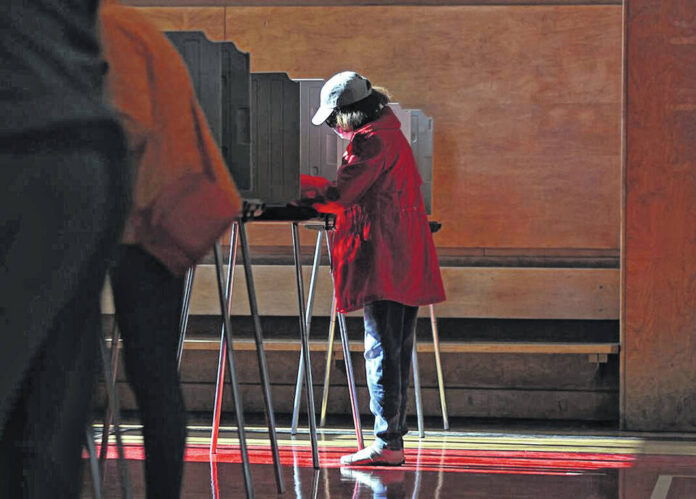COLUMBUS – The Ohio Senate advanced legislation Wednesday afternoon that could schedule an August election for the public to vote on whether to make it harder to amend the Ohio Constitution.
Senate Joint Resolution 2, which would put the question on the ballot, and Senate Bill 92, which makes the Aug. 8 election possible, passed along party lines. The resolution passed 26 to 7. The bill passed 25 to 8, with Rep. Nathan Manning, a North Ridgeville Republican voting with the Democrats.
Now, it’s up to the Ohio House. Both chambers must pass a joint resolution to put the issue before voters. That does not require Gov. Mike DeWine’s signature. However, SB 92 would require DeWine to sign off on the bill.
Lawmakers must pass both because, in December, they adopted legislation eliminating August special elections in most circumstances. DeWine signed that bill into law in January. It would have to change again, with DeWine’s signature or via an override by the legislature, to set an August election for the amendment issue.
Earlier Wednesday, a committee in the House passed a similar measure, House Joint Resolution 1, sending it to the floor. The committee was lively, with opponents repeatedly chanting “Shame!” when the committee ended testimony and voted for the bill. Democrats walked out. The Ohio Highway Patrol removed at least one person from the meeting.
If HJR 1 or SJR 2 were to pass public vote in August, it would pave a much harder road for a November election where abortion rights supporters are hoping to have their own issue at stake, an amendment that would enshrine reproductive rights. In most “purple” and “red” states, abortion rights supporters have prevailed in the 52% to 59% range, and a 60% supermajority in Ohio would likely defeat it.
Republicans in the Senate said constitution is a sacred document that shouldn’t be so easily amended.
“We’ve witnessed time and time again as special interest groups buy their way on the state ballot, only to spend millions of dollars drowning the airwaves seeking to secure permanent, fundal change,” said Theresa Gavarone, a Bowling Green Republican who is sponsoring both the resolution and bill, pointing to a constitutional amendment that enumerates the location of casinos.
The Ohio Constitution contains “the fundamental principles by which we will govern ourselves that outlines branches of government and the balance of power (and) is not to be subject to the whims of a society,” said Sen. Kristina Roegner, a Hudson Republican. “It’s not to be used as a receptacle for whatever the winds might be for that particular day.”
Sen. Kent Smith, a Euclid Democrat, was first to mention abortion on the Senate floor.
“The decision of whether or not to bear a child is central to a woman’s life, to her well-being and dignity,” he said. “It’s a decision that she wants to make for herself. When the government controls that decision for her, she’s being treated less than a full adult human responsible for her own choices.”
Sen. Andrew Brenner, a Columbus-area Republican, listed abortion as a reason the Senate should pass the resolution. He also said he’s opposed to a constitutional amendment proposal that would create a $15 an hour minimum wage.
“I don’t think the Ohio Constitution or any constitution should look like legislation,” Brenner said.
Sen. Bill DeMora, a Columbus Democrat, noted that the legislature passed a bill in December that got rid of most August elections. An election on Aug. 8 could cost $20 million.
“Shame on this body, for trying to do something so nefarious and sneaky,” DeMora said.
The House version of the bill did not make the House floor on Wednesday, due to the House calendar being decided a day before.
In the House committee, Tim Burga, president of the Ohio AFL-CIO, spoke against the HJR 1.
Collecting signatures from hundreds of thousands of Ohio voters in 44 counties – the current requirement in the winding process to get on the ballot – is a heavy lift. HJR 1 and SJR 2 would require signatures from all 88 counties, Burga said.
“Making petitioners hit those same signature thresholds in all 88 counties creates a barrier to the ballot that will almost certainly be unachievable,” he said. “In addition, once an issue makes it to the ballot, the campaign to obtain a majority ‘yes’ votes is very difficult as the success rate is just one in four.”
If it gets on the ballot, Jen Miller, president of the Ohio League of Women Voters, said the proposal will fail. She’s part of a 225-member coalition that’s opposed to changing the threshold.
“We will show up in droves to vote no, because this has been our right as citizens for a century,” she said.
Republicans behind the measure say that too many out-of-state, big moneyed groups come into Ohio and try to alter the state’s constitution. The Ohio Constitution contains too many sections that really should be state law, such as the location of casinos.







